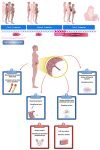Extracellular Vesicles-New Players in Cell-to-Cell Communication in Gestational Diabetes Mellitus
- PMID: 35203669
- PMCID: PMC8962272
- DOI: 10.3390/biomedicines10020462
Extracellular Vesicles-New Players in Cell-to-Cell Communication in Gestational Diabetes Mellitus
Abstract
Research in extracellular vesicles (EVs) has contributed to a better understanding of physiological and pathophysiological conditions. Biologically active cargo, such as miRNAs and proteins, is critical in many different biological processes. In this context, pregnancy is one of the most complex physiological states, which needs a highly regulated system to ensure the correct nourishment and development of the baby. However, pre-existent maternal conditions and habits can modify the EV-cargo and dysregulate the system leading to pregnancy complications, with gestational diabetes mellitus (GDM) being one of the most reported and influential. Calcification and aging of muscle cells, protein modification in vascular control or variations in the levels of specific miRNAs are some of the changes observed or led by EV populations as adaptation to GDM. Interestingly, insulin sensitivity and glucose tolerance changes are not fully understood to date. Nevertheless, the increasing evidence generated has opened new possibilities in the biomarker discovery field but also in the understanding of cellular mechanisms modified and involved in GDM. This brief review aims to discuss some of the findings in GDM and models used for that purpose and their potential roles in the metabolic alterations during pregnancy, with a focus on insulin sensitivity and glucose tolerance.
Keywords: extracellular vesicles; gestational diabetes mellitus; glucose tolerance; insulin sensitivity; pregnancy complications.
Conflict of interest statement
The authors declare no conflict of interest.
Figures


Similar articles
-
Extracellular vesicles and their potential role inducing changes in maternal insulin sensitivity during gestational diabetes mellitus.Am J Reprod Immunol. 2021 Feb;85(2):e13361. doi: 10.1111/aji.13361. Epub 2021 Feb 10. Am J Reprod Immunol. 2021. PMID: 33064367 Review.
-
Extracellular vesicle-mediated targeting strategies for long-term health benefits in gestational diabetes.Clin Sci (Lond). 2023 Aug 31;137(16):1311-1332. doi: 10.1042/CS20220150. Clin Sci (Lond). 2023. PMID: 37650554 Free PMC article. Review.
-
Extracellular vesicles as critical mediators of maternal-fetal communication during pregnancy and their potential role in maternal metabolism.Placenta. 2020 Sep 1;98:60-68. doi: 10.1016/j.placenta.2020.06.011. Epub 2020 Jul 2. Placenta. 2020. PMID: 33039033 Review.
-
miRNA Profiles in Extracellular Vesicles From Serum Early in Pregnancies Complicated by Gestational Diabetes Mellitus.J Clin Endocrinol Metab. 2019 Nov 1;104(11):5157-5169. doi: 10.1210/jc.2018-02693. J Clin Endocrinol Metab. 2019. PMID: 31058973 Free PMC article.
-
Regulatory roles of extracellular vesicles in pregnancy complications.J Adv Res. 2025 Feb 10:S2090-1232(25)00108-0. doi: 10.1016/j.jare.2025.02.010. Online ahead of print. J Adv Res. 2025. PMID: 39938794 Review.
Cited by
-
Parental obesity-induced changes in developmental programming.Front Cell Dev Biol. 2022 Oct 7;10:918080. doi: 10.3389/fcell.2022.918080. eCollection 2022. Front Cell Dev Biol. 2022. PMID: 36274855 Free PMC article. Review.
-
Streamlined Analysis of Maternal Plasma Indicates Small Extracellular Vesicles are Significantly Elevated in Early-Onset Preeclampsia.Reprod Sci. 2024 Sep;31(9):2771-2782. doi: 10.1007/s43032-024-01591-y. Epub 2024 May 22. Reprod Sci. 2024. PMID: 38777947 Free PMC article.
-
Extracellular Vesicles: the Next Frontier in Pregnancy Research.Reprod Sci. 2024 May;31(5):1204-1214. doi: 10.1007/s43032-023-01434-2. Epub 2023 Dec 27. Reprod Sci. 2024. PMID: 38151656 Review.
-
The immunological age prediction of monocytes indicates that gestational diabetes mellitus accelerates the aging of monocytes in offspring.Immun Ageing. 2025 May 13;22(1):18. doi: 10.1186/s12979-025-00513-z. Immun Ageing. 2025. PMID: 40361109 Free PMC article.
-
Proteomic profile of extracellular vesicles in maternal plasma of women with fetal death.J Matern Fetal Neonatal Med. 2023 Dec;36(1):2177529. doi: 10.1080/14767058.2023.2177529. J Matern Fetal Neonatal Med. 2023. PMID: 36813269 Free PMC article.
References
-
- Metzger B.E., Buchanan T.A., Coustan D.R., De Leiva A., Dunger D.B., Hadden D.R., Hod M., Kitzmiller J.L., Kjos S.L., Oats J.N., et al. Summary and Recommendations of the Fifth International Workshop-Conference on Gestational Diabetes Mellitus. Diabetes Care. 2007;30:S251–S260. doi: 10.2337/dc07-s225. - DOI - PubMed
-
- Salomón C., Westermeier F., Puebla C., Arroyo P., Guzmán-Gutiérrez E., Pardo F., Leiva A., Casanello P., Sobrevia L. Gestational Diabetes Reduces Adenosine Transport in Human Placental Microvascular Endothelium, an Effect Reversed by Insulin. PLoS ONE. 2012;7:e40578. doi: 10.1371/journal.pone.0040578. - DOI - PMC - PubMed
Publication types
Grants and funding
LinkOut - more resources
Full Text Sources

